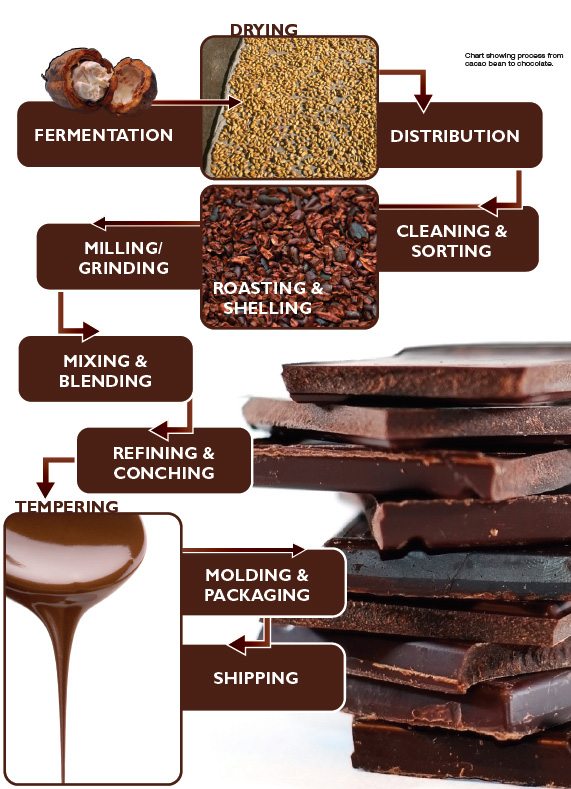
Chocolate: The word alone invokes pleasure for most of us. Its crisp, smooth texture with rich and bold flavor creates an always-satisfying experience. “Simple Magnificence: The Cacao Bean” walks us through the origins of chocolate’s fundamental ingredient – the cacao bean. The process flow diagram ( below) provides an overview of how cacao beans are transformed into one of the world’s most favored epicurean delights. Chocolate-making is a meticulous craft backed by hundreds of years of expertise and precision. Understanding the process of chocolate from the bean to the finished product will have you view your favorite chocolate dessert in a whole new light.

- Fermentation Cacao beans are removed from pods and left for about 3–7 days, usually under banana leaves. Left to ferment too long, the beans may become putrid, while too short a period results in bitterness and lack of flavor.1
- Drying The beans are laid out to dry in full sun. Bamboo mats are considered the ideal surface for bean drying.2
- Distribution The dried beans are shipped to factories all over the world for further processing.
- Cleaning & Sorting The cacao beans are washed to eliminate any residue or foreign objects, and are then dried. Beans from many origins may be combined to create unique flavor profiles.
- Roasting & Shelling The beans are roasted at a temperature and time relevant for their final application. Next, a hulling machine removes the outer shell, exposing the interior “nib” of the bean, which is the portion used to make chocolate. The nibs may undergo alkalization at this point to enhance flavor and color development.
- Milling/Grinding The nibs are finely ground into a dark, bitter liquid known as chocolate liquor or cocoa mass.3 This liquid is then used as an ingredient in chocolate. (Alternately, chocolate liquor may be pressed to separate it into cocoa powder and cocoa butter, which are used in a wide-range of food and nonfood applications.)
- Mixing & Blending Cocoa liquor is mixed with cocoa butter, sugar and milk (in the case of milk chocolate). Often other flavors such as vanilla extract, or emulsifying ingredients such as lecithin, may be added during blending, or later in the process. White chocolate does not contain any chocolate liquor, instead only the cocoa butter.
- Refining & Conching The mixture is refined by passing through a series of rollers until a smooth paste is achieved. The next step is conching, a kneading process that improves the smoothness, texture and aromas of the chocolate, and may take as long as a few days to complete.
- Tempering Tempering is a highly controlled heating and cooling process that serves to preserve the quality of the finished chocolate by preventing certain crystalline formations of the cocoa butter, which appear as fat bloom (the white discoloration of cocoa butter on hardened chocolate).
- Molding & Packaging The tempered chocolate may be molded into blocks, bars, chips, drops or any other desired shape. Other ingredients such as nuts, dried fruit, etc., may be added during molding. Packaging may be geared towards the retail market or bulk-style for further processing.
- Shipping Chocolate is a temperature-sensitive product and therefore shipping must be cool and controlled. HERSHEY’S® alone distributes more than a billion pounds of chocolate products each year!4
References:
1,3 Chocolate Making. 2010. Retrieved from Guittard Chocolate
Company: www.guittard.com/chocolate_making.asp
[August 11, 2010].
2 From Cocoa to Chocolate. (n.d.) Retrieved from Barry Callebaut: www.barry-callebaut.com/1525 [August 11, 2010].
4 Making Chocolate (2005). Retrieved from The Hershey Company: www.hersheys.com/discover/chocolate.asp# [August 11, 2010].
